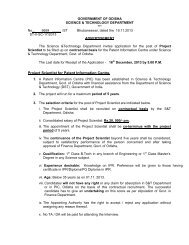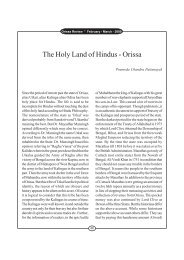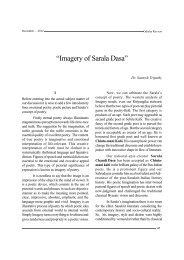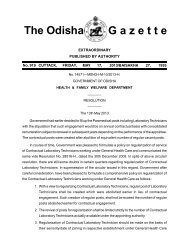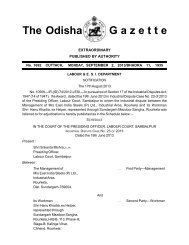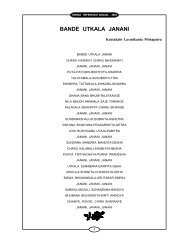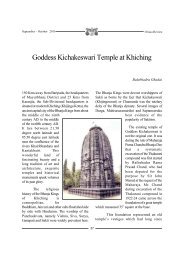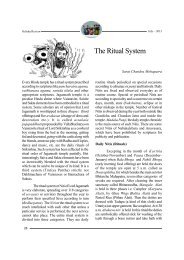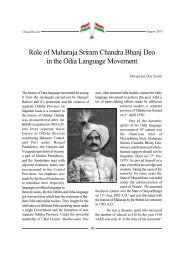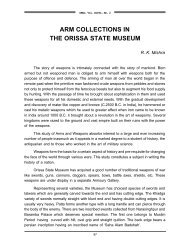Palm- Leaf Manuscripts: The Proud Possessions of Orissa
Palm- Leaf Manuscripts: The Proud Possessions of Orissa
Palm- Leaf Manuscripts: The Proud Possessions of Orissa
You also want an ePaper? Increase the reach of your titles
YUMPU automatically turns print PDFs into web optimized ePapers that Google loves.
PDF<br />
Documents<br />
Complete<br />
Click Here & Upgrade<br />
Expanded Features<br />
Unlimited Pages<br />
<strong>Orissa</strong> Review * November - 2005<br />
king, but as the palm-leaf was destroyed in fire,<br />
Maharaja Narendra regranted it in a copper plate<br />
charter in favour <strong>of</strong> Sankhaswami, son <strong>of</strong><br />
Bhasrutaswami. Maharaja Narendra was a<br />
Sarabhapuriya king <strong>of</strong> South Kosala in the 6th<br />
century A.D.<br />
<strong>The</strong>re are also many sculptural evidences<br />
regarding the use <strong>of</strong> palm-leaf manuscripts. <strong>The</strong><br />
earliest <strong>of</strong> these can be found in the Parsuramesvar<br />
temple at Bhubaneswar which was built during<br />
the rule <strong>of</strong> Sailodbhava dynasty (7th Century<br />
A.D.). Similar representations can be observed<br />
in the Muktesvar temple (10th century A.D.) and<br />
also the famous Sun temple <strong>of</strong> Konark (13th<br />
century A.D.). Another important sculptural<br />
evidence is an image <strong>of</strong> Buddha found at a temple<br />
in Haripur near Khurdha. In this sculpture one<br />
finds in the pedestal a scholar studying some holy<br />
scriptures in the shape <strong>of</strong> a stringed palm-leaf<br />
manuscript placed on Vyasasana. <strong>The</strong>re is a<br />
beautiful presentation <strong>of</strong> a scribe writing with a<br />
stylus on a palm-leaf in a sculpture <strong>of</strong> Jagannath<br />
temple <strong>of</strong> Dharakot.<br />
<strong>The</strong> entire Buddhist scripture<br />
Avatamsaka Sutra was written on palm-leaf<br />
manuscript and it was presented to Chinese<br />
emperor Te-Song by Subhakara Deva, the<br />
Bhaumakara king <strong>of</strong> <strong>Orissa</strong> with his own<br />
autograph. This was an event <strong>of</strong> eight century (798<br />
A.D.).<br />
<strong>The</strong> oldest datable palm-leaf manuscript<br />
now exant in <strong>Orissa</strong> State Museum is a copy <strong>of</strong><br />
the poetic work Abhinava Gita Govinda by Kavi<br />
Chandra Ray Divakara Mishra, inscribed by one<br />
Sri Sridhara Sharma. <strong>The</strong> date <strong>of</strong> the manuscript<br />
has been established as 6th April, 1494. <strong>The</strong> poet<br />
has <strong>of</strong>fered the work in the name <strong>of</strong> Gajapati<br />
Purushottama Deva.<br />
<strong>The</strong> concluding portion <strong>of</strong> the manuscript<br />
is called Pushpika or Colophon. It gives the name<br />
<strong>of</strong> the scribe and the date <strong>of</strong> copying just as we<br />
have today the name <strong>of</strong> the author and the<br />
publisher and the date <strong>of</strong> the publication <strong>of</strong> a<br />
printed book on its title page. In recording the<br />
date in the colophon, the scribe followed the anka<br />
or the regnal year <strong>of</strong> the Raja <strong>of</strong> Puri. <strong>The</strong> colophon<br />
sometimes mention the Oriya Sala or Sana year<br />
<strong>of</strong> an era which started on the twelfth day <strong>of</strong> bright<br />
fortnight <strong>of</strong> the Bhadra month <strong>of</strong> 593 A.D. During<br />
the reign <strong>of</strong> Akbar, Hijra or Amali Era was<br />
introduced in the manuscripts. In a few latter<br />
manuscripts, the Christian era called Samvatsara<br />
and the Christian month are given in colophon.<strong>The</strong><br />
Saka Era (Starting in 78 A.D.) has also been used.<br />
Sometimes the year has been given in a riddle or<br />
chronogram.<br />
In case <strong>of</strong> illustrated palm-leaf<br />
manuscripts, the introduction was always made<br />
with the picture <strong>of</strong> Ganesha, the god <strong>of</strong> learning<br />
and well being with the words Shri Ganeshaya<br />
Namah (Salutation to Ganesha) and Shri Shubham<br />
astu (let it be auspicious). Some Chitrapothis also<br />
had the picture <strong>of</strong> Sarasvati, the goddess <strong>of</strong><br />
learning on the front page. If the manuscript<br />
contained erotic text, (Rati-bandha) - it invariably<br />
had a picture <strong>of</strong> Kandarpa, the God <strong>of</strong> love. In<br />
many <strong>of</strong> Upendra Bhanjas Kavyas, the poet is<br />
shown paying his obeissance to Rama, Vishnu and<br />
other Gods.<br />
<strong>Palm</strong>-leaves and stylus were adopted as<br />
the sole writing material for writing the charya-<br />
Songs which are believed to be the oldest Oriya<br />
literary works. <strong>The</strong>se were composed in a period<br />
between 9th to 12th century A.D. Between the<br />
Charya Songs and Sarala Dass Mahabharata,<br />
no Oriya literary works have come to notice<br />
except some prose writing and a poem called<br />
Kalasa Chautisa. During this period, however,<br />
<strong>Orissa</strong> produced an enormous amount <strong>of</strong> Sanskrit<br />
literature, which includes books on astronomy,<br />
astrology, medicines. grammar, religion and law.<br />
38



